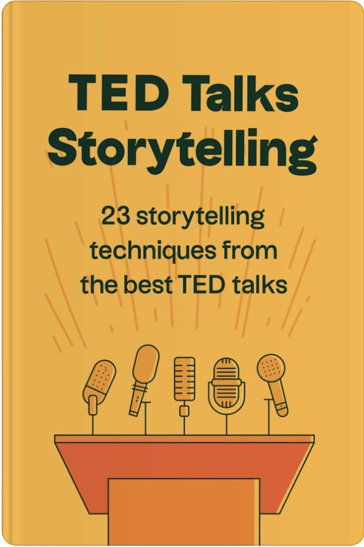Do you want to captivate your audience and leave a lasting impression? Look no further than the power of storytelling. In this summary, we’ll reveal the secrets behind great TED talks and how master storytellers use conflict, sensory details, and specific details to create engaging presentations. In the end, there are actionable tips for you to start improving your own presentations today.
Takeaways
What Makes a TED Talk Great?
- TED talks are short, 18-minute videos where experts distill their life’s work into one idea.
- Speakers choose a key takeaway message that the audience will remember.
- The best TED speakers are persuasive, influential, and confident on stage.
- The big secret behind great TED talks is storytelling.
- Master storytellers craft stories that allow them to share their message without lecturing the audience.
Captivate With a Story
Stories trigger the audience to search their memory banks for similar experiences
- The best way to start a presentation is with a story.
- It takes 30 seconds for a person to get bored with a speech.
- A powerful beginning is crucial to grab your audience’s attention.
- Introducing yourself and expressing gratitude is not the best way to start a presentation.
- A story can evoke emotions, memories, curiosity, and entertainment.
The Power of Conflict in Storytelling
- Conflict is a crucial element of a story’s body.
- Opposites that create tension make conflicts emotionally charged and irresistible.
- Conflict makes a story unpredictable and maintains the audience’s engagement, arouses emotions and gets the audience rooting for a character, and is what keeps the audience hooked on a presentation.
- Tense conflicts can have the audience glued to their seats, curious about what will happen next.
Bring Your Characters to Life with Sensory Details
- A great speech goes beyond the words used and creates mental pictures for the audience
- Creating powerful images helps the audience visualize the characters and their actions
- Descriptions bring characters to life and make a speaker a superior storyteller
- “Showing” a story instead of telling it is crucial for engaging the audience
- Providing sensory details enlivens characters and makes the audience familiar with them
- To captivate your audience, describe how characters look, smell, and act, among other sensory details.
Engage All of the 5 Senses
“Engaging an audience is more than just giving important information.”
Akash Karia
- We experience the world through our senses: sight, touch, smell, sound, and taste
- Detailed descriptions that appeal to the senses help listeners create mental motion pictures
- Using most or all of the 5 senses in your talks helps show the mental motion picture
- VAKOG is an acronym for the senses: visual, auditory, kinesthetic, olfactory, and gustatory
- Using sensory details like Mike Rowe did in his speech creates a vivid mental image for the audience
- Engaging all of the 5 senses in your storytelling helps make your presentation more memorable.
The Power of Specific Details
Specificity helps your audience see what you’re saying and adds internal credibility
- Specific details make a story in-depth and evocative
- Overly general details leave the audience with a vague image of the scene or characters
- Specific details help the audience compare and visualize the scene or characters
- Concrete details about people, setting, and time add credibility and engagement to the story
- Avoid non-specific language and use specific details to make your story graphic and engaging.
Positive-Message Stories
- TED talks fall into two types of stories: positive-message stories and negative-message stories
- Positive-message stories
- Show the protagonist overcoming conflict and changing their life for the better
- Teach valuable lessons and uplift the audience emotionally
- Don’t come across as a lecture and inspire people to overcome challenges in their lives.
- Negative-message stories
- Show the character failing to overcome difficulties and ending up in a worse situation
- Cleave the audience emotionally low, while positive-message stories leave them on a high note
Lighten Up Your Story with Spark, Change, and Takeaway
- The “spark” is a carefully articulated wisdom, process, or idea that helps the character overcome the conflict
- The “change” is the actual transformation that redirects the flow of the story
- The “takeaway” is the critical message that explains how the change occurred and what you should do
- A great story structure includes a character, conflict, spark, change, and takeaway message
- The takeaway message should be summarized in a short and memorable phrase
- Simplifying the structure of a great story makes it easier to create engaging stories.
Action Items
- Watch videos of great speakers: Learn from the best by watching videos of great speakers. Take note of what works and what doesn’t and apply it to your own presentation.
- Write down your story: Write down the full text of your story and revise it as many times as necessary. This will help you refine your message and ensure that it flows smoothly.
- Practice in front of the mirror: Practice your presentation in front of the mirror to perfect your delivery and body language. This will also help you identify any nervous habits you may have.
- Practice with different people: Practice telling your story to different people, such as family, friends, or even the janitor down the hallway. This will help you get comfortable with telling your story to strangers and receive feedback to improve your presentation.
Remember, preparation is key to nailing your next presentation. By following these tips, you’ll be well on your way to delivering a powerful and engaging presentation.

